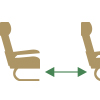With new advances in amenities and comfort, traveling by motorcoach may be the best form of travel available today. If sitting inches away from the next passenger in a pressurized metal tube 30,000 feet in the air doesn’t sound appealing, it’s time to take a look at why motorcoach travel is, quite literally, the way to go.
Table of Contents
What is a Motorcoach?
The term “motorcoach” has roots in the horse-drawn carriage. The ability to carry luggage and mail was a crucial feature in coaches of the old days. The modern application of the word was first applied to railway carriages in the 19th century, and later to motorized vehicles.
A motorcoach, or over-the-road bus, is defined as a vehicle intended for long-distance transportation of passengers. The construction of the vehicle is characterized by an elevated passenger deck above a baggage compartment.
To be classified as a motorcoach, the vehicle must be at least 35 feet in length and carry a minimum of 30 passengers. Standard city transit buses, trolleys and streetcars do not fall under the definition of a motorcoach.
In a typical year, the use of a single motorcoach includes the following:
- 16,100 passenger trips
- 1.9 million passenger miles
- 3.4 employees
- 8,600 gallons of fuel
- 52,400 actual miles traveled
- 56% for charter and tourism
- 44% for fixed-route services
According to recent statistics, the motorcoach industry employs approximately 132,000 people and runs over 30,000 vehicles. Small companies offering fewer than 25 motorcoaches comprised 94 percent of all motorcoach companies.
Who is Traveling by Motorcoach?
The motorcoach industry is quite large. In 2012, the earliest year that data was recorded, the motorcoach industry in North America provided 637 million passenger trips.
Typical services offered by motorcoach include the following:
- Chartered service
- Tour service
- Sightseeing service
- Airport shuttle service
- Special operations
- Commuter services
The motorcoach industry serves a wide range of people, from student to senior, and from one-time rider to daily commuter. Motorcoach serves various industries, ranging from travel to leisure to commuter services, which make up the bulk of passenger transportation in North America.
Why Travel by Motorcoach?
Traveling by motorcoach is not the speediest option for long-distance overland travel, and that may be its only drawback. However, when every other aspect of long-distance transportation is considered, motorcoach often places itself as the more appealing option.
Here are the top seven reasons to travel by motorcoach:
- Driving can be stressful. Avoid stressful driving situations and opt for motorcoach travel. With a professional driver behind the wheel, one needn’t worry about maps, navigation, parking, back-seat drivers or other annoying distractions.
- Motorcoach makes for great sightseeing. The best way to travel across the country is to enjoy the view while doing so. With two eyes either firmly on the road or staring at the bottom of a tray table, the grandeurs of nature remain unseen. When traveling by motorcoach, however, the beauty of the countryside is on glorious display.
- You can sleep comfortably on motorcoach. Sleeping behind the wheel is out of the question. And on a plane, reclining a seat by only five degrees is not conducive to quality rest. Modern motorcoaches provide comfortable recliner seats without the drone of a jet engine right outside the window.
- Travel by motorcoach is conducive to socializing. It is much easier to visit with friends and fellow travelers in a motorcoach than in any vehicle. There may be no better way to meet new people or spend time with friends or family than in the comfort of a luxurious motorcoach.
- Entertainment is included. While many flights offer in-flight entertainment services, they often come with separate charges that can be quite expensive. These amenities are often included when traveling by motorcoach.
- Professional services are offered. Today’s motorcoach drivers take pride in their vehicles and the services they offer. Motorcoaches are kept in luxurious condition. Drivers will help passengers off the motorcoach with a smile and take special care loading and unloading baggage.
- Curbside service is offered. Since charter motorcoaches can go relatively anywhere with ease, they offer a huge convenience factor. There is no need to travel through unknown locations when a service is available that picks up at the traveler’s door and drops off at the destination.
While travel by motorcoach may be one of the most comfortable and convenient options, there are other benefits to consider as well. Could it be that travel by motorcoach is cheaper, safer, and greener than other forms of long-distance travel?
Is Motorcoach Cheaper than Other Transportation Methods?
In a new study asking if travel by motorcoach is better on the wallet than travel by train, the American Bus Association Foundation found that on a cost-per-passenger basis, travel by motorcoach was 25% less than comparable Amtrak service.
Motorcoach travel usually involves a large amount of people chartering a single vehicle. When dividing each traveler’s share of the cost, it can end up being much more inexpensive than other modes of transportation, including car and airplane.
To test this theory, we planned a hypothetical trip from Washington D.C. to New York. The bride and groom and thirty-five friends and family are traveling to the Big Apple for their dream wedding at the Prince George Ballroom.
We analyzed the lowest per person available air fare, train fare, cost by car and cost by coach and found the following:

Motorcoach travel is the most economical option. Though travel by car comes close, coordinating a convoy of dozens of vehicles doesn’t sound easy. Besides, motorcoaches provide a better environment for interacting with friends and family on the trip.
Something else to consider when evaluating cost is baggage. Traveling by either air or car severely limits the number and size of bags that can be stored. Although many airlines offer the ability to bring extra bags, this is often accompanied by significant fees. Motorcoach travel allows passengers to store bags below the passenger deck as well as the compartments overhead, which have much more room than overhead bins on airplanes.
The common refrain is that the more inexpensive something is, the less safe it is. Since travel by motorcoach is the more inexpensive option, does that mean it is less safe?

Is Motorcoach Safer Than Other Transportation Methods?
Fatality rates per mode of transportation are measured per passenger-mile. It is important to compare the data this way because we are looking for information on fatalities, as opposed to vehicle crashes.
In analyzing the fatality rate per billion passenger-miles, the following information was gleaned:
- Car – 7.2
- Airplane – 2.3
- Bus/Motorcoach – 2.0
- Train – 0.2
Car travel is far more dangerous than other methods. If that same wedding party of thirty-five people were to drive to New York, they would need ten cars, rather than one plane or bus, greatly increasing the odds of an accident.
According to accident statistics released by the National Highway Traffic Safety Administration,

Though train travel is far safer than any other transportation method, the numbers are a bit deceiving. Passenger train options are only available in a few areas of the country, mainly on either coast. If the average number of motorcoach passengers were to be ranked against the average number of train passengers, the safety factor seems to balance. Annually, seven times more people travel by motorcoach than by train.
Is Motorcoach Greener than Other Transportation Methods?
Viewing the beautiful countryside from the comfort of a motorcoach reminds passengers of the need to help keep such beauty intact. Every aspect of life can now be measured by the scale of one’s carbon footprint.
Today’s modern motorcoach has become much more fuel efficient and environmentally friendly than other methods of transportation. On a per passenger basis, motorcoaches are one of the cleanest ways to travel.
Considering the amount of people transported on a motorcoach, the mode of transportation is remarkably efficient. According to the most recent data for motorcoaches, their average fuel efficiency is 6.1 miles per gallon. While this may not sound like much, it must be viewed from the perspective of how many passengers they carry.
The industry average for motorcoach capacity is 39.3 passengers per vehicle. When comparing that measure to the average mile per gallon, motorcoaches achieve an average of 222.7 passenger miles per gallon (pMPG) of fuel.
Here is a comparative analysis of pMPG by mode of transportation:
- Motorcoach – 222.7 pMPG
- Heavy Rail – 190.6 pMPG
- Passenger Car (4 people) – 81.66 pMPG
- Passenger Car (3 people) – 61.2 pMPG
- Passenger Car (2 people) – 55.9 pMPG
- Domestic Air – 54 pMPG
- Passenger Car (1 person) – 27.9 pMPG
When taking into account the number of passengers, motorcoach travel consumes far less energy than other modes of transportation. The raw data for carbon emissions also puts motorcoach at the top of the list.
Here is an analysis of the average carbon dioxide emissions per passenger-mile:
- Motorcoach – 75 grams
- Heavy Rail – 160 grams
- Passenger Car (4 people) – 100 grams
- Passenger Car (3 people) – 140 grams
- Passenger Car (2 people) – 180 grams
- Domestic Air – 190 grams
- Passenger Car (1 person) – 230 grams
Clearly, if measured by per passenger-miles per gallon or carbon dioxide emissions, motorcoaches are superior to other modes of transportation. Imagine that each motorcoach is replacing as many as 50 passenger cars on the road and it’s easy to see the impact.
While the data may slightly fluctuate by measuring an older fleet, motorcoach travel remains the greenest travel option. But is it the most luxurious?
Motorcoach Travel: Is it More Luxurious than Other Transportation Methods?
Motorcoach travel offers a level of comfort and luxury not readily afforded by other modes of transportation. While the passengers of a car may enjoy a movie on a mounted DVD player, the driver can’t enjoy that privilege.
Airplane travel offers more entertainment options at a cost, but falls short in the area of comfort. Modern motorcoaches provide plush seating with ample space. On a motorcoach, two full armrests are an attainable luxury.
Motorcoaches also provide the latest in technologies meant to distract a bored passenger. Many offer Wi-Fi service without the extra cost, something not readily provided with other transportation methods.
New advanced fleets offer enticing amenities, such as the following:
 |
Plush reclining seats – Airplanes are cramped. It is no secret that the lack of space is a major complaint about modern air travel. Motorcoaches provide a level of comfort that cannot easily be afforded in planes or cars. |
 |
Individual air-conditioning vents – Cars offer a similar level in the area of internal climate control. Airplanes struggle to come close with a meager vent that seems to only leak air onto passengers. |
 |
Extra leg room – Many modern coaches offer seating that reclines more than car seats. Some operators offer limited group-size seating for extra room to stretch out and relax. |
 |
High-tech sound systems – Tour directors need sound that projects and reaches everyone inside the cabin. New coaches also offer sound systems fully integrated into seats, allowing passengers to enjoy movie and sound that won’t disturb those around them. |
 |
Video monitors – The beauty about movies on motorcoaches is that no one is going to ask for a credit card number. Many screens offer full high-definition video for no additional cost. |
 |
Smoke-free coaches – Gone are the days when one could simply “light up” in the passenger compartment of a motorcoach. Though there will always be a place to indulge in the occasional |
 |
Emergency restrooms – While most motorcoaches offer restrooms, they are termed emergency restrooms because some vehicles are meant to only be drained at the final stop. But if the stretch of road is long and the need arises, restrooms are always there. |
The Future of Travel by Motorcoach
Travel by motorcoach is expected to grow in the coming years. According to the ABA census report, year-over-year increases in motorcoach travel from 2011-2012 amounted to 1.7 percent a year, which represented a total of 6% over the prior two-year period.
Demand from travelers, group tours, and bus visitations are expected to generate more than $55 billion in economic transactions annually. Motorcoaches are also crucial to rural America, where there may be few or no alternative travel options. Motorcoaches serve over 14 million rural and mobility-impaired Americans.
Across North America, parks, restaurants, hotels, museums, monuments and other attractions all stand to gain from motorcoach tours. Able to market to 40 travelers at a time, motorcoach travel offers the best return on investment for most businesses.
Considering all other options, travel by motorcoach is the most inexpensive, safest, greenest and most luxurious form of travel available today. With the industry continuing to grow and modern technologies advancing all levels of the consumer experience, it appears motorcoach travel will reign supreme for quite some time.
For more information regarding Executive Coach and our fleet of luxury motorcoaches, contact us today.





